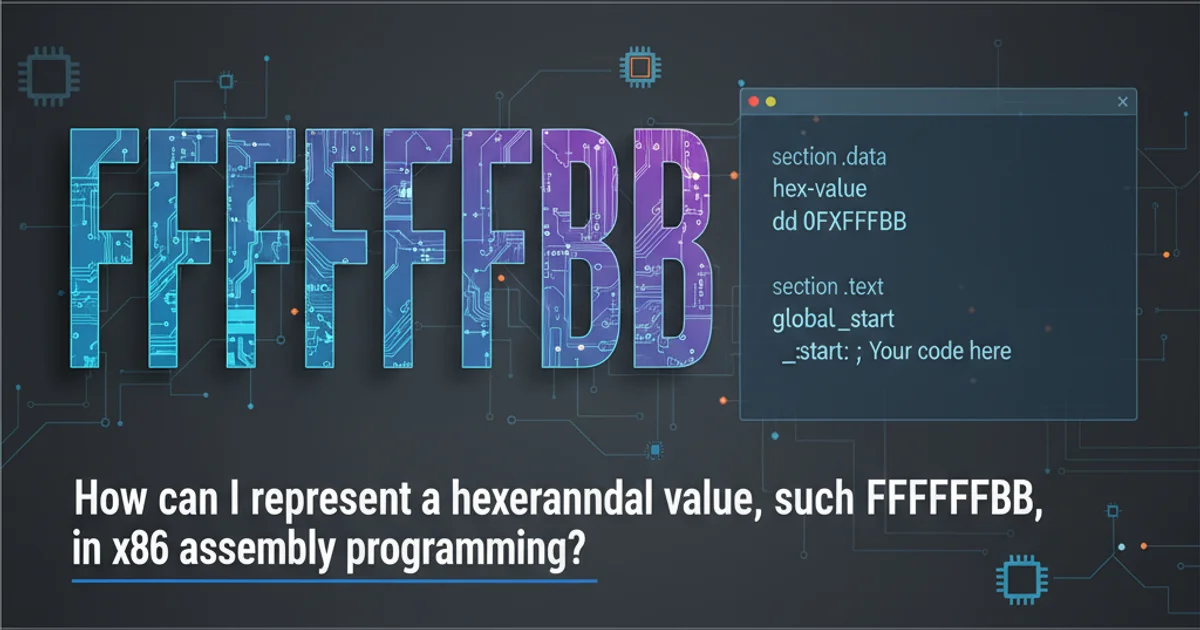How can I represent a hexadecimal value, such as FFFFFFBB, in x86 assembly programming?
Categories:
Representing Hexadecimal Values in x86 Assembly

Learn how to correctly represent and use hexadecimal values like FFFFFFBB in x86 assembly language, covering common directives and instructions.
Working with hexadecimal values is fundamental in low-level programming, especially in x86 assembly. Hexadecimal provides a compact and human-readable way to represent binary data, which is crucial for memory addresses, register contents, and immediate data. This article will guide you through the various methods of defining and manipulating hexadecimal values in x86 assembly, focusing on common assemblers like NASM and MASM.
Understanding Hexadecimal Notation in Assembly
Different assemblers use slightly different conventions for denoting hexadecimal numbers. It's important to be aware of these variations to avoid syntax errors. The core idea remains the same: a prefix or suffix indicates that the number should be interpreted as base-16 rather than base-10.
flowchart TD
A[Start] --> B{Choose Assembler};
B -- NASM --> C[Prefix with 0x];
B -- MASM --> D[Suffix with h];
C --> E[Example: 0xFFFFFFBB];
D --> E;
E --> F[End];Hexadecimal Notation Flowchart for x86 Assemblers
Representing Hexadecimal Literals
The most common way to represent a hexadecimal value like FFFFFBB is as an immediate operand. The specific syntax depends on the assembler you are using. For values that start with a letter (A-F), a leading zero is often required to distinguish them from labels or variable names.
0FFh instead of FFh in MASM, or 0xFF instead of xFF in NASM if x was not a prefix.NASM/GAS Syntax
; NASM/GAS (AT&T syntax for GAS) ; Prefix with 0x
section .data my_hex_value_nasm dd 0xFFFFFFBB
section .text global _start
_start: mov eax, 0xFFFFFFBB ; Move the hexadecimal value into EAX ; ... rest of your code
MASM Syntax
; MASM (Intel syntax) ; Suffix with h, require leading zero if first digit is A-F
.data my_hex_value_masm DD 0FFFFFBBh
.code main PROC mov eax, 0FFFFFBBh ; Move the hexadecimal value into EAX ; ... rest of your code main ENDP END
Using Hexadecimal Values in Instructions
Once defined, hexadecimal values can be used directly as immediate operands in various instructions. This is common for setting register values, defining memory contents, or performing bitwise operations. The assembler handles the conversion to the appropriate binary representation.
; Example using a hexadecimal value in an instruction (NASM syntax)
section .text
global _start
_start:
mov eax, 0xFFFFFFBB ; Load 0xFFFFFFBB into EAX
and eax, 0x000000FF ; Mask EAX to keep only the lowest byte (BBh)
add ebx, 0x100 ; Add 256 (0x100) to EBX
cmp ecx, 0xDEADBEEF ; Compare ECX with 0xDEADBEEF
; Exit (Linux specific)
mov eax, 1
xor ebx, ebx
int 0x80
Demonstrates using hexadecimal values as immediate operands in NASM.
FFFFFBB is a 32-bit hexadecimal number. In x86, this would typically fit into a 32-bit register like EAX, EBX, ECX, EDX, or a 64-bit register like RAX (where it would be zero-extended or sign-extended depending on the instruction and context).Common Pitfalls and Best Practices
While representing hexadecimal values is straightforward, there are a few common pitfalls to avoid. Always double-check your assembler's specific syntax rules and be mindful of the operand size. Using comments to explain complex hexadecimal values can also improve code readability.
1. Verify Assembler Syntax
Before writing any code, confirm whether your assembler (e.g., NASM, MASM, GAS) uses 0x prefix or h suffix for hexadecimal literals. This is the most common source of errors.
2. Use Leading Zeros for Clarity
If a hexadecimal number starts with a letter (A-F), always prepend a 0 (e.g., 0FFh or 0xFF). This prevents the assembler from misinterpreting it as a label or variable name.
3. Match Operand Size
Ensure the hexadecimal value's size matches the instruction's operand size. For example, mov al, 0xFF is valid for an 8-bit register, while mov eax, 0xFFFFFFFF is for a 32-bit register.
4. Comment Complex Values
For hexadecimal values that represent flags, masks, or specific memory addresses, add comments to explain their purpose. This greatly enhances code maintainability.